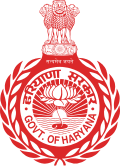State governments of India
State Governments of the 28 Indian states and 3 union territories From Wikipedia, the free encyclopedia
State Governments of India are the governments ruling over the 28 states and 3 union territories (there are 8 union territories but only 3 union territories have Legislative Assembly as well as governments) of India with the head of Council of Ministers in every state being the Chief Minister, who also serves as the head of the government. Power is divided between the Union government (federal government) and the state governments. The federal government appoints a Governor for each state, who serves as the ceremonial head of state, and a Lieutenant Governor (or Administrator) for certain union territories, whose powers vary depending on the specific union territory.
Each state has a legislative assembly. A state legislature that has one house – the State Legislative Assembly (Vidhan Sabha) – is a unicameral legislature. A state legislature that has two houses – the State Legislative Assembly and State Legislative Council (Vidhan Parishad) – is a bicameral legislature. The Vidhan Sabha is the lower house and corresponds to the Lok Sabha while the Vidhan Parishad is the upper house and corresponds to the Rajya Sabha of the Parliament of India.
While the Union government handles defence, external affairs etc., the state government deals with internal security and other state issues. Income for the Union government is from customs duty, excise tax, income tax etc., while state government income comes from sales tax (VAT), stamp duty etc.; now these have been subsumed under the various components of the Goods and Services Tax.
The Sarkaria Commission was set up to review the balance of power between states' and the Union governments. The Union government can dissolve a state government in favour of President's rule if necessary, subject to certain conditions, as ruled by the Supreme Court of India in S. R. Bommai v. Union of India. It is for 5 years only.
Legislative
Summarize
Perspective
For every state, there is a legislature, which consists of a Governor and either one or two houses.[1]
- 3 additional seats are nominated by Government of India
Legislative Council
6 out of 28 states have bicameral legislatures, namely Andhra Pradesh, Bihar, Karnataka, Maharashtra, Telangana, and Uttar Pradesh, with the remaining states having a unicameral one. Parliament may, by law, provide for the abolition of an existing Legislative Council or for the creation of one where it does not exist, if the proposal is supported by a resolution of the Legislative Assembly of the state concerned.
The Legislative Council of a state comprises not more than one-third of the total number of members in the legislative assembly of the state and in no case fewer than 40 members. About one-third of members of the Council are elected by members of the legislative assembly from amongst persons who are not its members, one-third by electorates consisting of members of municipalities, district boards and other local authorities in the state, one-twelfth by an electorate consisting of persons who have been, for at least three years, engaged in teaching in educational institutions within the state not lower in standard than secondary school and a further one-twelfth by registered graduates of more than three years' standing. Remaining members are nominated by the Governor from among those who have distinguished themselves in literature, science, art, cooperative movement and social service. Legislative Councils are not subject to dissolution but one-third of their members retire every second year.
Legislative councils by ruling parties
No legislative council (30)
| Ruling party | States/UTs | |
|---|---|---|
| NDA (4)[4] | ||
| Bharatiya Janata Party | 2 | |
| Telugu Desam Party | 1 | |
| Janata Dal (United) | 1 | |
| INDIA (2)[5] | ||
| Indian National Congress | 2 | |
The Bharatiya Janata Party-led National Democratic Alliance is in power in 4 legislative councils; the Indian National Congress-led Indian National Developmental Inclusive Alliance is in power in 2 legislative councils; and 30 other states/union territories do not have a legislative council.
Legislative Assembly
The Legislative Assembly of a state consists of not more than 500 and not fewer than 60 members (Legislative Assembly of Sikkim has 32 members, while Puducherry has 33, Goa and Mizoram have 40 seats each vide Article 371F of the Constitution) chosen by direct election from territorial constituencies in the state. Demarcation of territorial constituencies is to be done in such a manner that the ratio between population of each constituency and number of seats allotted to it, as far as practicable, is the same throughout the state. The term of an assembly is five years unless it is dissolved earlier.
Legislative assemblies by ruling parties
This article needs to be updated. (December 2024) |

Others (1)
| Ruling party | States/UTs | |
|---|---|---|
| NDA (20)[6] | ||
| Bharatiya Janata Party | 14 | |
| Telugu Desam Party | 1 | |
| Janata Dal (United) | 1 | |
| All India N.R. Congress | 1 | |
| Nationalist Democratic Progressive Party | 1 | |
| National People's Party | 1 | |
| Sikkim Krantikari Morcha | 1 | |
| INDIA (9)[7] | ||
| Indian National Congress | 3 | |
| Communist Party of India (Marxist) | 1 | |
| Aam Aadmi Party | 1 | |
| All India Trinamool Congress | 1 | |
| Dravida Munnetra Kazhagam | 1 | |
| Jammu & Kashmir National Conference | 1 | |
| Jharkhand Mukti Morcha | 1 | |
| Others(1) | ||
| Zoram People's Movement | 1 | |
| President’s rule | 1 | |
The Bharatiya Janata Party led National Democratic Alliance is in power in 20 legislative assemblies; the Indian National Developmental Inclusive Alliance is in power in 9 legislative assemblies; 1 legislative assemblies are ruled by other parties/alliances; 1 legislative assembly is under President’s rule and 5 union territories do not have a legislative assembly.
Powers and Functions
State legislature has exclusive powers over subjects enumerated in the State List (List II of the Seventh Schedule) of the Constitution and concurrent powers over those enumerated in sub List III. Financial powers of legislature include authorization of all expenditure, taxation and borrowing by the state government. The Legislative Assembly alone has the power to originate money bills. The Legislative Council can only make recommendations in respect of changes it considers necessary within a period of fourteen days of the receipt of money bills from the Legislative Assembly, which can accept or reject these recommendations.
The Governor of a state may reserve any Bill for the consideration of the President. Bills relating to subjects like the compulsory acquisition of property, measures affecting powers and position of High Courts, and the imposition of taxes on storage, distribution, and sale of water or electricity in Inter-state River or river valley development projects should necessarily be so reserved. No Bills seeking to impose restrictions on inter-state trade can be introduced in a state legislature without the previous sanction of the President.
State legislatures, apart from exercising the usual power of financial control, use all normal parliamentary devices like questions, discussions, debates, adjournments, and no-confidence motions and resolutions to keep a watch over the day-to-day work of the executive. They also have their own committees on estimates and public accounts to ensure that grants sanctioned by the legislature are properly utilized.
There are, overall, 4,121 legislative assembly seats in states and Union territories of India.[8][9][10] Andhra Pradesh abolished its Legislative Council in 1984, but set up a new Legislative Council following elections in 2007.[11]
Executive
Summarize
Perspective
The state executive[12] consists of a Governor and the State Council of Ministers, with the Chief Minister as its head.
Governor
The Governor of a state is appointed by the President of India for a term of five years and holds office during their pleasure. Only Indian citizens above 35 years of age are eligible for appointment to this office.
Executive power of the state is vested in the Governor. All Governors are obligated to discharge their constitutional functions such as the appointment of the Chief Minister of a state, sending a report to the President on the failure of the Constitutional machinery in a state or in respect of matters relating to assent to passing a bill in the state assembly.
Similarly, in respect of Arunachal Pradesh, its Governor has special responsibility under Article 371H of the Constitution with respect to law and order and in discharge of his functions in relation thereto. The Governor exercises his individual judgement as to the action to be taken after consulting the Council of Ministers. These are, however, temporary provisions. If the President of India, on receipt of a report from Governor or otherwise is satisfied that it is no longer necessary for the Governor to have special responsibilities with respect to law and order, he may so direct by an order.
Likewise, in the Sixth Schedule which applies to tribal areas of Assam, Meghalaya, Tripura and Mizoram as specified in para 20 of that Schedule, discretionary powers are given to the Governor in matters relating to sharing of royalties between the district councils and the state government. The Sixth Schedule vests additional discretionary powers in the Governors of Mizoram and Tripura in almost all their functions (except approving regulations for levy of taxes and money lending by non-tribal district councils) since December 1998. In Sikkim, the Governor has been given special responsibility for peace and social and economic advancement of different sections of population.
Council Of Ministers
The Chief Minister is appointed by the Governor, who also appoints other ministers on the advice of the Chief Minister. The Council of Ministers is collectively responsible to the Legislative Assembly of the state.
The Council of Ministers with the Chief Minister as its head aids and advises the Governor in exercise of his functions except in so far as he is by or under the Constitution required to exercise his functions or any of them at his discretion. In respect of Nagaland, its Governor has special responsibility under Article 371 A of the Constitution with respect to law and order and even though it is necessary for him to consult Council of Ministers in matters relating to law and order, he can exercise his individual judgement as to the action to be taken.
Government Secretariat
The State Secretariat serves as the administrative headquarters of a state government, functioning as the central hub for policy formulation, implementation, and interdepartmental coordination. This complex of buildings houses the offices of the Chief Minister, cabinet ministers, and Secretaries, who are senior civil servants (typically Indian Administrative Service officers) responsible for the administrative oversight of various government departments.[13]
The Secretariat is the top most echelon of the State administration and its main function is to assist the political executive – the Chief Minister and other Ministers - in maintaining peace and law and order and designing policies for the socio-economic development of the State as well as in carrying out legislative responsibilities of the government.The political executive is elected for a fixed tenure, but the Secretariat consists of civil servants and others who are permanent employees of the government.
State government functionaries includes:
- Chief Minister: The elected head of the government. Chief minister heads a state government's council of ministers and can be deputised in that role by a deputy chief minister. The chief minister generally selects the chief secretary and can also allot departments to the cabinet ministers of their state and ministers of state.
- Cabinet Minister: The political head of the department, responsible for the overall policy direction and functioning of the department. They are the political head of their departments. They are accountable to the state legislature.
- Minister of State (MoS): A Minister of State is a junior minister in the Council of Ministers in the State Government who may assist a cabinet minister or have independent charge of a ministry. A Minister of State with independent charge is a minister without an overseeing Cabinet Minister in the government.
- Chief Secretary: The Chief Secretary acts as the principal advisor to the chief minister on all matters of state administration. The Chief Secretary acts as an ex-officio secretary to the state cabinet, therefore called Secretary to the Cabinet. The Chief Secretary, an IAS officer, is the highest-ranking executive official and civil servant of the government of an Indian state.
- Secretary to Government: a senior civil servant (typically an IAS officer), serves as the administrative head of a ministry/department within the Secretariat. This individual advises the Minister, oversees policy implementation, and manages the ministry/department's administrative functions. The Secretary is supported by special secretaries, additional secretaries, joint secretaries, deputy secretaries, under secretaries, and other secretariat staff.
The Chief Ministers frequently assumes responsibility for several key ministerial portfolios, including but not limited to Departments of Home and General Administration.
Each secretariat department is in charge of a number of executive departments. The executive departments/agencies implement the government policies and works at field level. This number varies over a wide range with some departments taking charge of a much larger number of executive heads than others. Some of the secretariat departments are engaged in advisory and controlling functions and therefore do not have executive departments reporting to them. Examples are Departments of Law, Finance, etc.
- The executive head of a government department, often designated as Director, Commissioner, Chief, or other title, leads the operational arm of the department, commonly referred to as the Directorate, Commissionerate, or simply the department. The executive department (also known as field department, bureau or agency) is headed by a specialist in the relevant field, who may or may not be a IAS officer. This individual is responsible for the implementation and execution of policies and programs formulated by the Secretariat. They oversee the day-to-day administration and operations of the department. Examples include the Directorate of Agriculture, Directorate of Urban Affairs, Directorate of Medical Education, Directorate of School Education, Commissionerate of Land Revenue, Commissionerate of Transport, and Commissionerate of Labour. In some cases, the head of a department may hold the title of Director General, as in the case of the Director General of Police, Director General of Fire and Rescue Services or Inspector General, such as the Inspector General of Registration. They report to the government through the concerned Secretary of the Secretariat Department.
Judiciary
State High courts have jurisdiction over the whole state, but report to the Supreme Court of India, which may override the high court's judgments and rulings.
List of current state governments
See also
References
Wikiwand - on
Seamless Wikipedia browsing. On steroids.

























